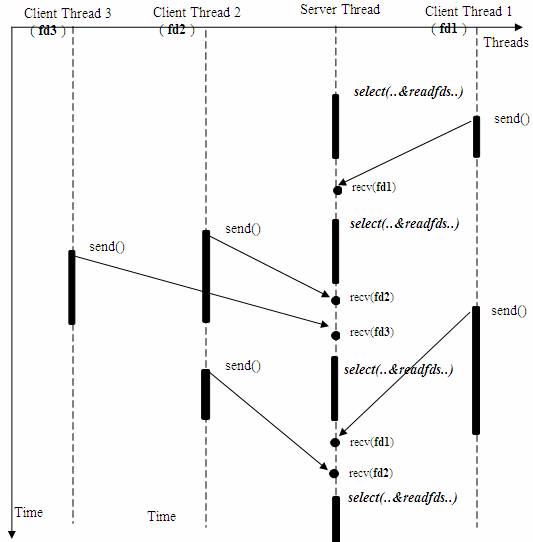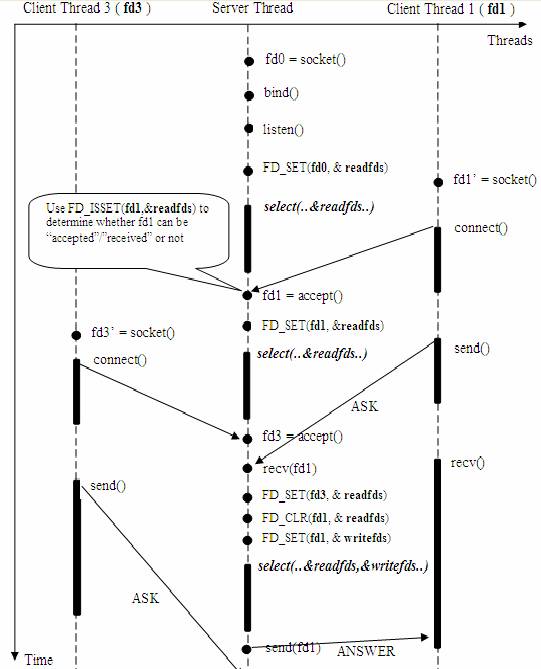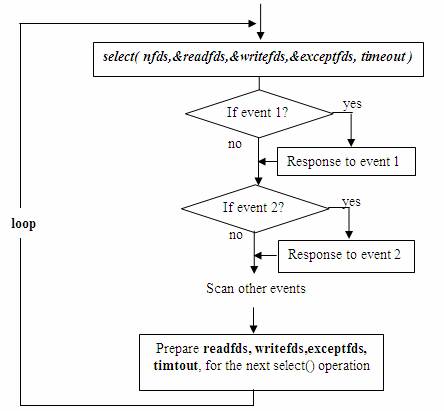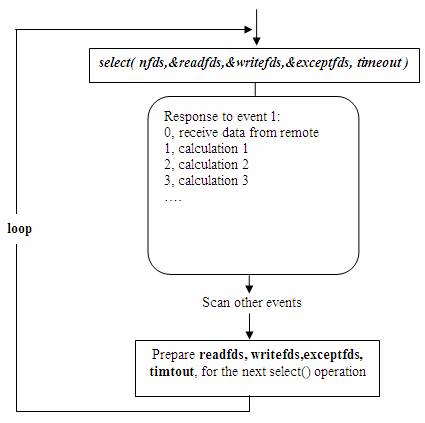python 3下基于select模型的事件驱动机制程序
来源:互联网 发布:python和java的区别 编辑:程序博客网 时间:2024/06/18 16:52
它的基本原理就是select/epoll这个function会不断的轮询所负责的所有socket,当某个socket有数据到达了,就通知用户进程。它的流程如图:
当用户进程调用了select,那么整个进程会被block,而同时,kernel会“监视”所有select负责的socket,当任何一个socket中的数据准备好了,select就会返回。这个时候用户进程再调用read操作,将数据从kernel拷贝到用户进程。这个图和blocking IO的图其实并没有太大的不同,事实上,还更差一些。因为这里需要使用两个system call (select 和 recvfrom),而blocking IO只调用了一个system call (recvfrom)。但是,用select的优势在于它可以同时处理多个connection。(多说一句。所以,如果处理的连接数不是很高的话,使用select/epoll的web server不一定比使用multi-threading + blocking IO的web server性能更好,可能延迟还更大。select/epoll的优势并不是对于单个连接能处理得更快,而是在于能处理更多的连接。)
在IO multiplexing Model中,实际中,对于每一个socket,一般都设置成为non-blocking,但是,如上图所示,整个用户的process其实是一直被block的。只不过process是被select这个函数block,而不是被socket IO给block。
所以,IO multiplexing Model的特点就是两个阶段都阻塞,但是等待数据阻塞在select上,拷贝数据阻塞在recfrom上。
在多路复用模型中,对于每一个socket,一般都设置成为non-blocking,但是,如上图所示,整个用户的process其实是一直被block的。只不过process是被select这个函数block,而不是被socket IO给block。因此select()与非阻塞IO类似。
大部分Unix/Linux都支持select函数,该函数用于探测多个文件句柄的状态变化。下面给出select接口的原型:
FD_ZERO(int fd, fd_set* fds)
FD_SET(int fd, fd_set* fds)
FD_ISSET(int fd, fd_set* fds)
FD_CLR(int fd, fd_set* fds)
int select(int nfds, fd_set *readfds, fd_set *writefds, fd_set *exceptfds,
struct timeval *timeout)
这里,fd_set 类型可以简单的理解为按 bit 位标记句柄的队列,例如要在某 fd_set 中标记一个值为16的句柄,则该fd_set的第16个bit位被标记为1。具体的置位、验证可使用 FD_SET、FD_ISSET等宏实现。在select()函数中,readfds、writefds和exceptfds同时作为输入参数和输出参数。如果输入的readfds标记了16号句柄,则select()将检测16号句柄是否可读。在select()返回后,可以通过检查readfds有否标记16号句柄,来判断该“可读”事件是否发生。另外,用户可以设置timeout时间。
下面将重新模拟上例中从多个客户端接收数据的模型。

图7 使用select()的接收数据模型
述模型只是描述了使用select()接口同时从多个客户端接收数据的过程;由于select()接口可以同时对多个句柄进行读状态、写状态和错误状态的探测,所以可以很容易构建为多个客户端提供独立问答服务的服务器系统。如下图。

图8 使用select()接口的基于事件驱动的服务器模型
这里需要指出的是,客户端的一个 connect() 操作,将在服务器端激发一个“可读事件”,所以 select() 也能探测来自客户端的 connect() 行为。
上述模型中,最关键的地方是如何动态维护select()的三个参数readfds、writefds和exceptfds。作为输入参数,readfds应该标记所有的需要探测的“可读事件”的句柄,其中永远包括那个探测 connect() 的那个“母”句柄;同时,writefds 和 exceptfds 应该标记所有需要探测的“可写事件”和“错误事件”的句柄 ( 使用 FD_SET() 标记 )。
作为输出参数,readfds、writefds和exceptfds中的保存了 select() 捕捉到的所有事件的句柄值。程序员需要检查的所有的标记位 ( 使用FD_ISSET()检查 ),以确定到底哪些句柄发生了事件。
上述模型主要模拟的是“一问一答”的服务流程,所以如果select()发现某句柄捕捉到了“可读事件”,服务器程序应及时做recv()操作,并根据接收到的数据准备好待发送数据,并将对应的句柄值加入writefds,准备下一次的“可写事件”的select()探测。同样,如果select()发现某句柄捕捉到“可写事件”,则程序应及时做send()操作,并准备好下一次的“可读事件”探测准备。下图描述的是上述模型中的一个执行周期。

图9 多路复用模型的一个执行周期
这种模型的特征在于每一个执行周期都会探测一次或一组事件,一个特定的事件会触发某个特定的响应。我们可以将这种模型归类为“事件驱动模型”。
相比其他模型,使用select() 的事件驱动模型只用单线程(进程)执行,占用资源少,不消耗太多 CPU,同时能够为多客户端提供服务。如果试图建立一个简单的事件驱动的服务器程序,这个模型有一定的参考价值。
但这个模型依旧有着很多问题。首先select()接口并不是实现“事件驱动”的最好选择。因为当需要探测的句柄值较大时,select()接口本身需要消耗大量时间去轮询各个句柄。很多操作系统提供了更为高效的接口,如linux提供了epoll,BSD提供了kqueue,Solaris提供了/dev/poll,…。如果需要实现更高效的服务器程序,类似epoll这样的接口更被推荐。遗憾的是不同的操作系统特供的epoll接口有很大差异,所以使用类似于epoll的接口实现具有较好跨平台能力的服务器会比较困难。
其次,该模型将事件探测和事件响应夹杂在一起,一旦事件响应的执行体庞大,则对整个模型是灾难性的。如下例,庞大的执行体1的将直接导致响应事件2的执行体迟迟得不到执行,并在很大程度上降低了事件探测的及时性。

图10 庞大的执行体对使用select()的事件驱动模型的影响
幸运的是,有很多高效的事件驱动库可以屏蔽上述的困难,常见的事件驱动库有libevent库,还有作为libevent替代者的libev库。这些库会根据操作系统的特点选择最合适的事件探测接口,并且加入了信号(signal) 等技术以支持异步响应,这使得这些库成为构建事件驱动模型的不二选择。下章将介绍如何使用libev库替换select或epoll接口,实现高效稳定的服务器模型。
实际上,Linux内核从2.6开始,也引入了支持异步响应的IO操作,如aio_read, aio_write,这就是异步IO。
python下则是将其封装了, 对返回值做了修改, 相比较原来在C下的返回值(一个整型, 判断是否调用成功), python下的调用返回值则是直接返回的可读, 可写, 异常状态序列。C中的可读, 可写, 异常状态的序列, 则是直接将其写入了参数里面, 也就是说输入输出参数都是一样的, python这样的封装设计还是很不错的。我设计了一个粗陋的基于事件机制的select调用:
服务器端:
import selectimport socketimport queuefrom time import sleepclass TCPServer: def __init__(self, server, server_address, inputs, outputs, message_queues): # Create a TCP/IP self.server = server self.server.setblocking(False) # Bind the socket to the port self.server_address = server_address print('starting up on %s port %s' % self.server_address) self.server.bind(self.server_address) # Listen for incoming connections self.server.listen(5) # Sockets from which we expect to read self.inputs = inputs # Sockets to which we expect to write # 处理要发送的消息 self.outputs = outputs # Outgoing message queues (socket: Queue) self.message_queues = message_queues def handler_recever(self, readable): # Handle inputs # 循环判断是否有客户端连接进来, 当有客户端连接进来时select 将触发 for s in readable: # 判断当前触发的是不是服务端对象, 当触发的对象是服务端对象时,说明有新客户端连接进来了 # 表示有新用户来连接 if s is self.server: # A "readable" socket is ready to accept a connection connection, client_address = s.accept() self.client_address = client_address print('connection from', client_address) # this is connection not server connection.setblocking(0) # 将客户端对象也加入到监听的列表中, 当客户端发送消息时 select 将触发 self.inputs.append(connection) # Give the connection a queue for data we want to send # 为连接的客户端单独创建一个消息队列,用来保存客户端发送的消息 self.message_queues[connection] = queue.Queue() else: # 有老用户发消息, 处理接受 # 由于客户端连接进来时服务端接收客户端连接请求,将客户端加入到了监听列表中(input_list), 客户端发送消息将触发 # 所以判断是否是客户端对象触发 data = s.recv(1024) # 客户端未断开 if data != b'': # A readable client socket has data print('received "%s" from %s' % (data, s.getpeername())) # 将收到的消息放入到相对应的socket客户端的消息队列中 self.message_queues[s].put(data) # Add output channel for response # 将需要进行回复操作socket放到output 列表中, 让select监听 if s not in self.outputs: self.outputs.append(s) else: # 客户端断开了连接, 将客户端的监听从input列表中移除 # Interpret empty result as closed connection print('closing ', s.getpeername()) # 获取客户端的socket信息 # Stop listening for input on the connection if s in self.outputs: self.outputs.remove(s) self.inputs.remove(s) s.close() # Remove message queue # 移除对应socket客户端对象的消息队列 del self.message_queues[s] return "got it" def handler_send(self, writable): # Handle outputs # 如果现在没有客户端请求, 也没有客户端发送消息时, 开始对发送消息列表进行处理, 是否需要发送消息 # 存储哪个客户端发送过消息 for s in writable: try: # 如果消息队列中有消息,从消息队列中获取要发送的消息 message_queue = self.message_queues.get(s) send_data = '' if message_queue is not None: send_data = message_queue.get_nowait() except queue.Empty: # 客户端连接断开了 self.outputs.remove(s) else: # print "sending %s to %s " % (send_data, s.getpeername) # print "send something" if message_queue is not None: s.send(send_data) else: print("client has closed") # del message_queues[s] # writable.remove(s) # print "Client %s disconnected" % (client_address) return "got it" def handler_exception(self, exceptional): # # Handle "exceptional conditions" # 处理异常的情况 for s in exceptional: print('exception condition on', s.getpeername()) # Stop listening for input on the connection self.inputs.remove(s) if s in self.outputs: self.outputs.remove(s) s.close() # Remove message queue del self.message_queues[s] return "got it"def event_loop(tcpserver, inputs, outputs): while inputs: # Wait for at least one of the sockets to be ready for processing print('waiting for the next event') # 开始select 监听, 对input_list 中的服务器端server 进行监听 # 当socket调用send, recv等函数时, 就会再次调用此函数, 这时返回的第二个参数就会有值 readable, writable, exceptional = select.select(inputs, outputs, inputs) if readable is not None: tcp_recever = tcpserver.handler_recever(readable) if tcp_recever == 'got it': print("server have received") if writable is not None: tcp_send = tcpserver.handler_send(writable) if tcp_send == 'got it': print("server have send") if exceptional is not None: tcp_exception = tcpserver.handler_exception(exceptional) if tcp_exception == 'got it': print("server have exception") sleep(0.8)if __name__ == '__main__': server_address = ('localhost', 8090) server = socket.socket(socket.AF_INET, socket.SOCK_STREAM) inputs = [server] outputs = [] message_queues = {} tcpserver = TCPServer(server, server_address, inputs, outputs, message_
- python 3下基于select模型的事件驱动机制程序
- 基于事件的select:WSAEventSelect模型
- 基于select模型的python echo server
- 基于platform机制的驱动模型
- 基于platform机制的驱动模型
- 基于platform机制的驱动模型
- 基于platform机制的驱动模型
- 基于platform机制的驱动模型
- Win32基于事件驱动的消息机制
- 一种基于任务(事件驱动)的程序运行模型研究
- Linux基于事件驱动的程序框架
- .基于事件套接字集合的select模型
- 基于事件套接字集合的select 模型
- 基于select模型的udp客户端实现超时机制
- python 事件驱动编程模型
- 基于select模型的多人聊天程序(C++)
- 分布式应用中基于事件驱动的应用开发模型
- Netty 基于事件驱动模型实现的异步IO
- 基于condition 实现的线程安全的优先队列(python实现)
- 从零开始搭建一个项目框架MVVM(OC)
- 测量View的宽高,避免为零
- 蓝牙 Mesh会是最好的物联网协议吗?
- Java引用类型 Java类型转换疑惑
- python 3下基于select模型的事件驱动机制程序
- MySQL--子查询
- 正则表达式-字符串分割
- 搭建Spark所遇过的坑
- 解决ajax返回打开新窗口被浏览器拦截问题
- python 生成目录树
- JavaScript学习笔记
- Linux查看程序端口占用情况
- MyBatis动态SQL语法



